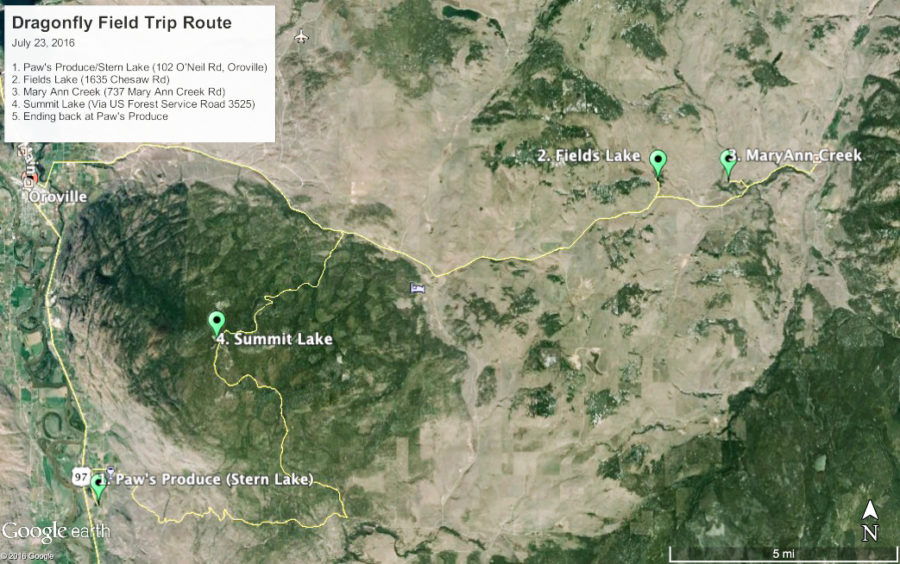Dragonfly Field Trip
Dragonflies and damselflies are often called birdwatchers’ insects. Active and brilliantly colored, these four-winged predators fly everywhere over pristine wetlands. Their very different-looking larvae are dominant predators in the water below. They have the best vision and the most versatile flight of any insects, and their sex life is similarly superlative.
In 2015, Dennis Paulson, one of the most knowledgeable naturalists in the Northwest, provided a profusely illustrated lecture as part of the indoor Highland Wonders series. In 2016, he shared his interest in the biodiversity and biology of dragonflies and damselflies by taking a group outdoors. Below are the species we saw on the field trip; all photos by Dennis Paulson:
The numerous lakes in the north Okanogan have diverse dragonfly and damselfly faunas. On Saturday, July 23, Dennis provided a hands-on field experience focused on the lives of dragonflies and damselflies in our region. We took a group into the field to visit several lakes in the Oroville area, Molson, and Mt Hull, beginning and ending the day in the valley, visiting a variety of habitats used by dragonflies for breeding, feeding, and completing their life cycle. We identified species, and watched for interesting territorial and reproductive behaviors that these species display. We carried nets to capture individuals to show them in the hand, as a close-up look is a great way to augment seeing them in the field. We also scooped some larvae/nymphs from the water to view the other part of their life cycle.

Dennis would say there are no insects more interesting than dragonflies and damselflies. They are common, but because of their association with wetlands, many people go through life with little contact with these wonders of nature. “Any well-rounded naturalist should have that contact, and this is such an opportunity,” Paulson said. “We have to preserve our natural ecosystems, as much for ourselves as for the animals and plants with which we share the world. Understanding those systems and their animals and plants are essential to their conservation. Thus natural history is our most important science.”
A poem written by field trip participant, Rhackett:
Damels and Dragons
Gathered together in Paws fruit stand parking lot,
17 people, young and old alike,
Intended to study Damsels and Dragons fly.
Lead by the man who wrote the book:
"Dragonflies and Damselflies of the West"
Dennis Paulson, quite an honor.
What a pleasure to see a young family
Enjoy each others company.
Sharing their technique with us
Swoop and wrap the net motion that's savvy
For catching the insects zipping around.
Gotta be quick --and lucky.
Want to find Dragonflies?
Look for fresh water
They spend most of their lives as larvae.
Sure they get et, also eat their fair share of mosquitoes.
The ones who survive emerge that much stronger
Doesn't take long to outgrow what's casing them in.
Once they emerge as an adult fully formed.
Equipped to take a more prominent part in the food chain.
Or bite in self defense.
Just have a short time to find a mate,
lay eggs, do their part
to sustain the cycle of life of a pond.
So we're looking for Damsels but what we got
Was a heron flying away.
An eyeful of beauty; reeds and Loosestrife
A noxious weed, hiding poison ivy
But, undeniable gorgeous
In that setting a frame for the Osprey
Diving and catching a fish right in front of us.
We suspect Julie called him in just for our pleasure.
Finally a Pacific Forktail was caught
Black abdomen, blue back and blue eyes
And a pair of Bluets
You should see them in magnification.
Moving on to Field's Lake (thanks for permission)
Our fist sight a Cooper's Hawk chased by Kingbirds
Distracted from catching their fair share of Damselflies.
Like birds, Dragons and Damsels fly
Only they have 4 wings
each articulated individually.
They can feather each wing, control the pitch, flex the tip;
Counter-balanced by a black dot called the stigma.
For exquisite control of the speed and direction, even hover.
Full speed to full stop faster than you can imagine.
We examined a Northern Spreadwing and a Blue-Eyed Darner.
Farther along Mary Ann Creek
A 12 spotted Skimmer demonstrated
One hunting strategy : perch and search.
Eyes specialized, designed with many facets
To recognize motion just the right size of their prey.
Swoop and snatch food right out of the air,
Then return to the same spot.
Gives us plenty of time to appreciate his beauty and technique.
Summit Lake brought a whole new habitat
Some new plants I've never noticed before.
I don't hang out in bogs much.
Mare's Tail only one specie all over the world.
A couple of mints and (what was that berry/flower?)
A florescent yellow glob on a stump
(I just had to touch it)
Turned out to be some form of slime mold.
Kids caught a this year's live-born garter snake.
We all got our feet wet.
Not that many Dragons and Damsels around
Must be between cycles?
Early spring, late rain will disrupt them.
Still we managed to catch
White-Faced Meadowhawk (red)
An American Emerald
Belted Whiteface
Something variable
One last exploration a scoop through the mud
Revealed an amazing diversity of larva, water bugs
Of all sizes and a polliwog - a spotted frog!
"She's a spotted frog, sitting on a log. living in a bog,
She's Happy." by Digital Deb
I'm happy too.
Made some new friends.
Hope I see them again
On an OHA nature walk.
Thanks Julie for what you do
Opening space and awareness for sharing
delight in our fragile and precious Highland eco- community.
Rhackett 2016
dragonflies, education, events, field trip, highland wonders, insects